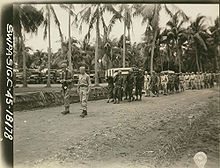James Leo Dalton II (January 20, 1910 – May 16, 1945) was a general and commander of United States Army forces during World War II. He graduated from West Point in 1933[1] and earned the Silver Star during the strategically significant Guadalcanal Campaign in which he commanded the 161st Infantry Regiment as a colonel.
James Leo Dalton II | |
|---|---|
 James Dalton (left) with Douglas MacArthur, most likely on Luzon in 1945 | |
| Nickname(s) | Dusty |
| Born | January 20, 1910 New Britain, Connecticut |
| Died | May 16, 1945 (aged 35) Luzon, Commonwealth of the Philippines |
| Allegiance | United States of America |
| Service | United States Army |
| Years of service | 1933–1945 |
| Rank | Brigadier general |
| Commands | 161st Infantry Regiment |
| Battles / wars | |
| Awards | |



Dalton later commanded the 161st during the New Georgia Campaign in 1943 and Battle of Luzon in 1945 before being promoted and reassigned as assistant commander of the 25th Infantry Division. He was killed by a Japanese sniper during the Battle of Balete Pass on May 16, 1945.
Birth and schooling
editDalton was born in New Britain, Connecticut but moved to Naugatuck with his family at a very young age. There he attended Saint Francis of Assisi School, and in 1927 he graduated from Naugatuck High School. In 1929 he entered West Point, graduating in 1933, when he transferred from cavalry to infantry.
Early military history
editDalton was posted at Pearl Harbor during the Japanese attack in 1941 and in January 1943 his regiment, the 161st Rifle (Infantry) Regiment, was sent to Guadalcanal, as part of the 25th Infantry Division's deployment to the island. The 161st took part in the final weeks of the campaign. For his duties during this campaign, Dalton was awarded the Silver Star and was promoted to lieutenant-colonel, then colonel.
Dalton was given command of the 161st in the closing days of the Guadalcanal Campaign[2] after its previous commander, Colonel Clarence Orndorff, was ordered back to the United States to recover from malaria. Initially, the 161st was a National Guard regiment, but having seen combat in the Guadalcanal campaign and taken in many replacements the regiment gradually had lost that title. After Guadalcanal the 161st was ordered to New Georgia Island to link up with the 145th and 148th Infantry Regiments, in an attempt to take out the Japanese airfield at Munda Point. On arrival at New Georgia Island on July 22, 1943, Dalton's regiment was placed under the command of General Robert S. Beightler. In a difficult campaign, in which his regiment was unable to make gains due to heavy enemy defensive positions, Dalton's regiment was also blamed by Colonel Baxter of the 148th for failures in the field. Beighter, although a fellow Ohio Guardsman of Baxter, decided that Dalton's command was sound and was able to remove Baxter from his position through a fortuitous element of Baxter's ill health.[3]
Later military service and death
editAfter the 161st was deployed to the Philippines during the Battle of Luzon, Dalton was promoted to brigadier general and reassigned as assistant commanding general of the 25th Infantry Division. Soon after, Dalton was killed in action by a Japanese sniper during the Battle of Balete Pass on May 16, 1945. The pass where Dalton died was renamed in his honor after the battle, and is referred to as Dalton Pass today.[4] Dalton was one of only 11 US general officers killed in action during World War II.[5]
Dalton was buried at USAFE Cemetery #1, Santa Barbara, Pangasinan, Luzon on May 18, 1945.[6] His remains, like the other documented American soldiers who were killed and buried in various wartime cemeteries during the ongoing fighting, were later interred in the Manila American Cemetery (Plot D, Row 15, Grave 109)[7]
Notes
edit- ^ Ohl, John Kennedy; Minuteman, The Military Career of General Robert S. Beightler, Lynne Rienner Publishers (2001) pg 109 ISBN 1-55587-923-3
- ^ Cartwheel: The reduction of Rabaul, John Miller Jr. Archived 2010-07-07 at the Wayback Machine Hyper War Website
- ^ Ohl; pg 123
- ^ Government of the Philippines
- ^ Cagley
- ^ US National Archives and Records Administration image #III-SC 265835.
- ^ American Battle Monuments Commission, http://ww2f.com/threads/greetings-from-the-philippines.42091/
References
editBooks
edit- Radike, Floyd W. (2003). Across the Dark Islands: The War in the Pacific. Random House Publishing. ISBN 0-89141-774-5. (Radike refers to Dalton as "Colonel Weston" in this memoir of Radike's experiences as an officer in the 161st Infantry Regiment during World War II.)
Web
edit- Cagley, Thomas R. (2005). "Relatively few U.S. generals lost their lives in World War II". World War II History. Retrieved 2008-08-18.
- GlobalSecurity.org. "1st Battalion – 161st Infantry Regiment". Retrieved 2008-08-18.
- Government of the Philippines. "DFA Announces Commemoration of Battle of Balete Pass". Retrieved 2008-08-18.[dead link]
- Lagasca, Charlie (2006-05-11). "World War II Vets to mark fall of 'Balete Pass'". Philippine Headline News Online. The Philippine Star. Archived from the original on 2008-09-24. Retrieved 2008-08-18.
- Lofgren, Stephen J. Northern Solomons. The U.S. Army Campaigns of World War II. United States Army Center of Military History. p. 36. Archived from the original on January 3, 2012. Retrieved October 18, 2006.
- Miller, John Jr. (1995) [1949]. Guadalcanal: The First Offensive. United States Army in World War II. United States Army Center of Military History. CMH Pub 5-3. Archived from the original on 2007-12-25. Retrieved 2006-07-04.
- Miller, John Jr. (1959). "CARTWHEEL: The Reduction of Rabaul". United States Army in World War II: The War in the Pacific. Office of the Chief of Military History, U.S. Department of the Army. p. 418. Retrieved October 20, 2006.
- Smith, Robert Ross (1993). "Triumph in the Philippines". United States Army in World War II. Office of the Chief of Military History, Department of the (US) Army. Retrieved 2008-08-18.